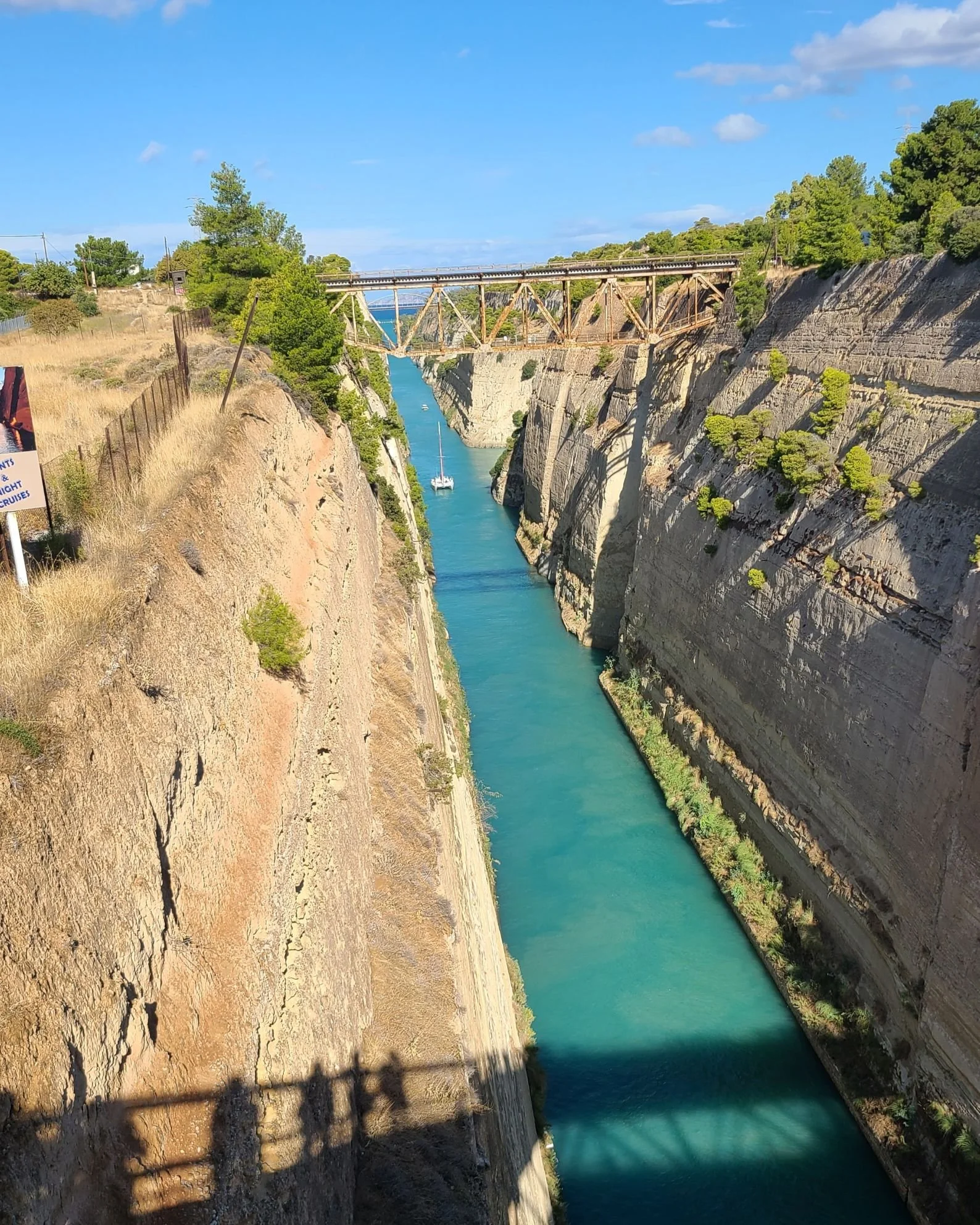An archaeologist’s view of Isthmia
International Archaeology Day 2025
Being a former Naval Officer, I’ve always wanted to see the Corinth Canal.[1] I had been to the Peloponnese before, but passed over it at night and didn’t catch a glimpse. This time I wanted to make sure to see it.
Northwest view of the Corinth Canal
My friend Caroline and I had traveled to Corinth and were staying at the American School at the ancient site of Corinth (Αρχαία Κόρινθος). People at the school recommended we visit the museum at Isthmia as well, although it wasn’t well known, but it has an amazing mosaic on the site. It sounded like a good reason to make the trek.
Archaeological Site and Museum of Isthmia [2]
It is a bit of a walk from the bridge over the canal to the archaeological site, and there isn’t much in the way of signage. Thank goodness for Google Maps.
We eventually made our way there, and found a small, unassuming museum with a few very nice artifacts, including coloured glass panels[3] and an old, wooden door. Some of the artifacts are shown below.
From the museum we went out onto the archaeological site of the Temple of Poseidon [4] which overlooks the Saronic Gulf.
Plan of the Sanctuary of Poseidon at Isthmia. Courtesy The Ohio State University Excavations at Isthmia. Frey & Gregory (2016) Fig. 1 [5]
No discussion on archaeology would be complete without at least one plan. This figure (above) shows the layout of the site. The signage on site was limited, so getting a good understanding of the site plan helps one envisage the whole.
While the remains visible on the ground are minimal, the most outstanding piece of architecture is the Roman Baths.[6] In particular the stunning black and white mosaic.
View of the remains of the Temple of Poseidon (facing East) (DA Donnelly, 2025)
“This mosaic is one of the best preserved and most impressive works to survive from ancient Isthmia and is in fact the largest monochrome mosaic in the eastern Mediterranean.”
A description of the two figural panels interprets them as “near mirror images showing a Triton with a Nereid on his back, each group surrounded by sea creatures.” [7] See photo of the mosaic below. Reference photos by Packard (1980) Plates 97-101, and drawing by Gregory (1995) Fig. 5.
Monochrome mosaic at the Roman Baths at Isthmia, mid 2nd century AC. (2025)
Seeing the baths and mosaic alone were well worth the hike. It is off the tourist’s beaten path, but worthy of a visit. I feel this site represents well the idea of International Archaeology Day. If you are planning a trip to the Peloponnese I highly recommend taking the time to visit the Temple of Poseidon at Isthmia.
[1] The Corinth Canal was conceived as early as the 7th century BC, but it was many centuries later under the Roman Emperor Nero (67 AD) that construction began (but wasn’t completed). Modern construction was undertaken by the French from 1882 to 1890 and then a Greek company completed the project in 1892. It is an engineering feat of gigantic proportions. https://en.wikipedia.org/wiki/Corinth_Canal
[2] https://archaeologicalmuseums.gr/en/museum/5df34af3deca5e2d79e8c1ba/archaeological-museum-of-isthmia
[3] The glass ‘mosaics’ of Kechries - Helen Miles Mosaics - https://helenmilesmosaics.org/ancient-mosaics/the-glass-mosaics-of-kechries/ ; Kiilerich, B &Torp, H. (2018) From Alexandria to Kenchreai? The Puzzle of the Glass Sectile Panels. In Across the Mediterranean Along the Nile Vol 2: Studies in Egyptology, Nubiology and Late Antiquity Dedicated to Laszlo Torok on the Occasion of his 75th Birthday. pp. 643-658.
[4] Temple of Isthmia - https://en.wikipedia.org/wiki/Temple_of_Isthmia ; Gebhard, Elizabeth R. and Hemans, Frederick P. (1992) University of Chicago Excavations at Isthmia, 1989: I. Hesperia, Volume 61, Number 1 (January 1992), pp. 1–77. https://www.jstor.org/stable/148182 ; Gebhard, Elizabeth R., and Frederick P. Hemans (1998) “University of Chicago Excavations at Isthmia: II.” Hesperia: The Journal of the American School of Classical Studies at Athens, vol. 67, no. 1, 1998, pp. 1–63. JSTOR, https://doi.org/10.2307/148419 ; Gebhard, E. R., Hemans, F. P., & Hayes, J. W. (1998) University of Chicago Excavations at Isthmia, 1989: III. Hesperia: The Journal of the American School of Classical Studies at Athens, 67(4), 405–456. https://doi.org/10.2307/148451
[5] Jon M. Frey, & Timothy E. Gregory. (2016) Old Excavations, New Interpretations: The 2008–2013 Seasons of The Ohio State University Excavations at Isthmia. Hesperia: The Journal of the American School of Classical Studies at Athens, 85(3), 437–490. https://doi.org/10.2972/hesperia.85.3.0437
[6] Gregory, T. E. (1995) The Roman Bath at Isthmia: Preliminary Report 1972-1992. Hesperia: The Journal of the American School of Classical Studies at Athens, 64(3), 279–313. https://doi.org/10.2307/148426 ; Packard, P. M. (1980) A Monochrome Mosaic at Isthmia. Hesperia: The Journal of the American School of Classical Studies at Athens, 49(4), 326–346. https://doi.org/10.2307/147913
[7] Gregory, 1995: 289; also Packard, 1980: 328.









